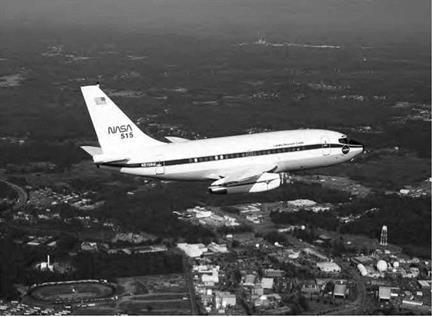Langley’s Airborne Trailblazer
The first Boeing 737 ever built was acquired by NASA in 1974 and modified to become the Agency’s Boeing 737-100 Transport Systems Research Vehicle. During the next 20 years, it flew 702 missions to help NASA advance aeronautical technology in every discipline possible, first as a NASA tool for specific programs and then more generally as a national airborne research facility. Its contributions to the growth in capability and safety of the National Airspace System included the testing of hardware and procedures using new technology, most notably in the cockpit. Earning its title as an airborne trailblazer, it was the Langley 737 that tried out and won acceptance for new ideas such as the glass
|
NASA’s Airborne Trailblazer is seen cruising above the Langley Research Center in Virginia. The Boeing 737 served as a flying laboratory for NASA’s aeronautics research for two decades. NASA. |
cockpit. Those flat panel displays enabled other capabilities tested by the 737, such as data links for air traffic control communications, the microwave landing system, and satellite-based navigation using the revolutionary Global Positioning System.[273]
With plans to retire the 737, NASA Langley in 1994 acquired a Boeing 757-200 to be the new flying laboratory, earning the designation Airborne Research Integrated Experiments System (ARIES). In 2006, NASA decided to retire the 757.[274]











